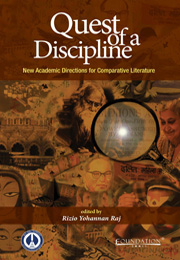Book contents
- Frontmatter
- Contents
- List of Contributors
- Acknowledgements
- Prologue to the “Quest'
- Introduction
- PART I Traditions and Manifestoes: Reflecting on Perspectives
- PART II The Quest Motif: Redefining the Scope of Comparative Literature
- PART III The Dynamics of Exchange: Genres, Areas and Disciplines
- 10 Text and Performance: A Study in Cultural Symbiosis with Special Reference to Kathakali
- 11 The Indian Cartoon Art: A Paradigm for the Emerging Text and Image Experience
- 12 Text and Alter Text: Chinese Literature in Indian Translations
- 13 Arabic Literature in Diaspora: An Example from South Asia
- 14 Literature, Arts and Social Sciences: Interdisciplinary Comparative Advantage
- PART IV India: A Curious Comparative Space
- Afterword: Comparative? Literature?
- Index
10 - Text and Performance: A Study in Cultural Symbiosis with Special Reference to Kathakali
from PART III - The Dynamics of Exchange: Genres, Areas and Disciplines
Published online by Cambridge University Press: 05 June 2012
- Frontmatter
- Contents
- List of Contributors
- Acknowledgements
- Prologue to the “Quest'
- Introduction
- PART I Traditions and Manifestoes: Reflecting on Perspectives
- PART II The Quest Motif: Redefining the Scope of Comparative Literature
- PART III The Dynamics of Exchange: Genres, Areas and Disciplines
- 10 Text and Performance: A Study in Cultural Symbiosis with Special Reference to Kathakali
- 11 The Indian Cartoon Art: A Paradigm for the Emerging Text and Image Experience
- 12 Text and Alter Text: Chinese Literature in Indian Translations
- 13 Arabic Literature in Diaspora: An Example from South Asia
- 14 Literature, Arts and Social Sciences: Interdisciplinary Comparative Advantage
- PART IV India: A Curious Comparative Space
- Afterword: Comparative? Literature?
- Index
Summary
INTRODUCTION
The concept of an audience that is distinct from a devotee watching a temple art form was virtually unknown in Kerala till the early decades of the twentieth century. Spectators could not be differentiated from idol-worshippers in the period prior to the institutionalization of performing arts. Worship of the mother-goddess and the folkritual entertainments linked to it had to inevitably allow entry to newer forms of religious entertainment in the public sphere. A case in point is the seventeenth century emergence of Ramanattam, which Kottarakkara Thampuran, a provincial ruler of South Kerala, had conceived and choreographed, assimilating make-up and costuming, verbal acting, angika and satwika abhinayas (acting through hand-gestures and body-movements, and emotive acting respectively) from the extant forms of ritual and folk traditions. Appreciation of poetry in such performances, soaked in devotion to gods and goddesses, was rather effortless for the masses because of their rootedness in a powerful oral tradition. Recitation/singing was central to the life of the god-fearing people who attended both rituals and forms of entertainments with equal responsibility and commitment. This could perhaps be the distant impact of the Bhakti Movement that catapulted the growth of high-density devotional music in the whole of South India, right from the twelfth century AD onwards, spearheaded by the saint Purandaradasa, although the devotional genre of music was prevalent perhaps in a crude form in the pre-Purandaradasa period.
When it comes to literature, the twelfth century poetic work, Jayadeva's Geetagovindam spontaneously found acceptance and admiration in the Hindu temples patronized by the Brahmins.
- Type
- Chapter
- Information
- Quest of a DisciplineNew Academic Directions for Comparative Literature, pp. 157 - 170Publisher: Foundation BooksPrint publication year: 2012

